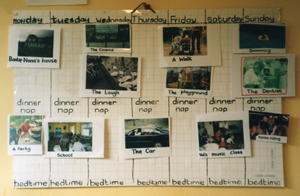A conversation tool for Samuel
A conversation tool for Samuel
Gilmore, J. (2005) A conversation tool for Samuel. Down Syndrome News and Update, 4(3), 95-95. doi:10.3104/practice.339
The objective of the conversation tool was to make it easy for Samuel to communicate what he did in preschool. He attends 'Horizons', a mainstream preschool, for 3 hours, 2 times a week. It is a big highlight of his week and he looks forward to going to school.
The objective was that he would be able to construct sentences telling me about one or two events that day. To meet this goal I knew Samuel would have to have practice rehearsing specific sentences, e.g. "I played with sand". I used photographs as a visual reminder of what happened using real life pictures of him at various preschool activities such as playing with sand, painting, listening at storytime and playing with children.
I put a text underneath the pictures to encourage a consistent language and laminated it on to an A4 sheet.
I asked the preschool to work with me to produce a feedback form of the events in his day. They have been extremely supportive of Samuel and have been very helpful in this regard.
I put the pictures into a book format but despite the fact that Samuel loves his home-made books it failed to 'hook' him. If I introduced the book to him it ruined the spontaneity that I hoped to achieve and he would often not co-operate .
I decided to post the pictures on the kitchen wall (on Velcro tabs) under the heading of "What did you do in school?" I felt that if Samuel was asked the question he could look at the pictures for the 'answers' while having his tea. This has worked out fantastically well. I find that meal times as a family are when a lot of conversation goes around and it was lovely to include Samuel in this sharing of the day's happenings.

"What did you do in school?"
It has been so successful that Samuel will always bring up the subject when he sees his pictures posted. Typically, it will work like this: he looks at me and says "School! School!" which is my cue to say "so, Samuel, what did you do in school today?" He will look at the photo posted of him doing a specific activity e.g. playing with sand, and say "Played with sand". With my feedback form I might add on and say "You played with David didn't you?" Within a few weeks of practising these phrases, Samuel has started to spontaneously tell me about his school day when I collect him in the car, without any visual or verbal prompts, using his 'learned' sentence structures. On these occasions I invariably find that the topic he tells me about is noted on his feedback form.
One other point: initially my opening question was written as "What did you do in school today?" but I dropped the "today" on the written picture as I found Samuel enjoyed talking about what happened in school at breakfast time the next morning, and it gave us another chance to work on his past tense grammar!
We became interested in the idea of making a visual calendar for Samuel, who is 3 years old, after reading about it in the DSii book Number Skills Development for Infants with Down Syndrome, 0-5 Years. The purpose of doing so was to present Samuel with a visual aid to comprehend the concept of time and to better prepare him for visits to the doctor, dentist, the dreaded hairdresser as well as more pleasant occasions such as birthdays and social outings !

Samuel's visual calendar measures 90cm by 60cm. The photos are 5" by 7" with large writing.
We got a large board 90x60cms and marked out clearly the days of the week. We used clear photos on laminated paper with a simple text underneath showing people, such as the dentist; activities, such as shopping; and places, such as the playground. It worked well to that end and indeed it helped him to learn the days of the week and remember that an event is happening tomorrow and not today. However, much more importantly, it has been the single greatest motivator for Samuel to initiate and sustain conversation. Its strength lies in the fact that it is very child centred. All children like to talk about what they did and what they are going to do, and Samuel is no exception.
Having a visual reminder of the week's happenings prompts him to talk (and as his speech can be very unclear, the picture calendar helps me to follow his lead and extend the conversation). You don't need a lot of events to talk about - for quiet days we just put up a picture of being at home. The calendar is placed in the kitchen in full view of Samuel at mealtimes and, as I said, it is a great opportunity for Samuel to tell me things (for a change!)

